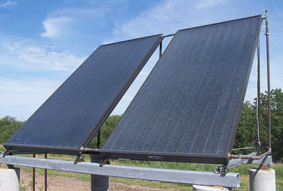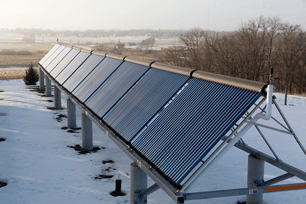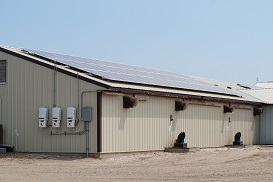The sun is one of the oldest energy sources, and scientists and engineers have been trying to harness the power of sunlight for a wide range of heating, lighting and industrial needs. In the United States, heating, ventilation and air-conditioning (HVAC) systems account for 30 percent of the energy used in commercial buildings and nearly 50 percent of the energy used in residential buildings.
Scientists at the West Central Research and Outreach Center (WCROC) are examining various ways to use solar energy. We collect data from these systems in order to evaluate the energy and economic performance as well as to establish baseline performance for future optimization.
Solar on Site
4 kW Pole mounted, located in pasture at the base of a small-scale wind turbine. This array was installed in 2017 and is tied into the WCROC guesthouse. It produces about 60% of the electricity used at the guesthouse.
20 kW Ground mount, located to the south of the WCROC machinery shed. Installed in 2017. Powers a heat pump system designed to cool sows and provide heat for piglets via in-floor heat exchangers in our farrowing barn. Now, it provides about 70% MORE electricity than is used in the farrowing barn. The extra electricity gets used in other buildings on the farm site.
27 kW Fixed array mounted at 20 degrees facing south, on top of our swine finishing barn. Installed in 2015. Produces approximately 30,000 kWh of electricity per year, which is about equal to what is consumed in the finishing barn each year.
30 kW Mounted at 35 degrees south and 8-10 feet from the ground, located in pasture to provide shading for grazing dairy herd. This is part of a new field of research, called Agrivoltaics, investigating how farming operations and solar energy can be done in the same space. Also supplies power to near-by fasting charging station for electric vehicles. Installed in 2018, and produces about 35,000 kWh per year. The fast charger is currently used about 90 times per year for a total of 2,220 kWh, but the number of uses is growing each year. The rest of the solar electricity production is used in the WCROC administration building.
50 kW Ground mount, flat top. Installed in 2016 to offset electricity use in the WCROC dairy milking parlor. This array uses reflectors to get more sunlight onto the solar panels and produces about 50,000 kWh per year which is almost 40% of the electricity used in the milking parlor.
240 kW In a joint project with U of MN-Morris, this array was installed on WCROC pastures in 2021 to provide sharing for our grazing dairy herd. Energy generated, an estimated 290,000 kWh/year, supports U of MN-Morris campus.
Flat-Plate Collectors

Flat-plate collectors have an insulated panel that contains a dark absorber plate behind the outside panel. Water is heated as it passes through tubing inside the collector. The flat-plate system at the WCROC provides hot water to the Administration building.
Evacuated Tube Collectors

Evacuated tube collectors work something like a thermos; liquid water is located at the core. Surrounding the water is a heat pipe that traps the heat as the sun warms the liquid. The hot vapor rises to the top of the heat pipe where it can be channeled into a building to be used. The system at the WCROC is designed to provide 15 tons of space heat for a portion of the WCROC Administration building.
Photovoltaic Systems
Solar cells, also called photovoltaic (PV) cells, convert sunlight into electricity. PV systems are found everywhere from wristwatches to airplanes to home and business use. Although solar energy continues to account for less than 1 percent of the U.S. energy supply, its contribution is expected to rise dramatically in the coming years.
Solar Use in Livestock Production

The swine facilities at the WCROC are used to model and demonstrate potential energy-efficient retrofits, including the installation of a 27 kW solar PV system on the roof of one of our finishing barns. Eventually, on-site renewable electric generation could supply some or all of the electric load thus allowing the building to approach net-zero (producing as much energy as is used).
We also utilize solar panels in our dairy pastures to provide shade for our grazing herd. Read more about our work in agrivoltaics.
Solar Chilling
Air conditioning can be produced from hot water via a sorption chiller. Water will remove heat from a cooling circuit when evaporated in order to be absorbed into a liquid salt solution or adsorbed on to a solid desiccant.
The solar air conditioning system at the WCROC uses a 10 ton absorption chiller. It is energized by hot water (158-203 degrees F) and the condenser is cooled with a wet cooling tower.
Resources
Learn more about solar thermal systems in the following hand-outs (PDFs):
- Solar thermal energy (.pdf)
- Solar hot water heating (.pdf)
- Solar thermal cooling (.pdf)
- Solar thermal systems for space heating and cooling (.pdf)
- Solar PV systems (.pdf)
- WCROC Energy Guidebook (.pdf): small-scale renewable energy systems for homes and businesses
